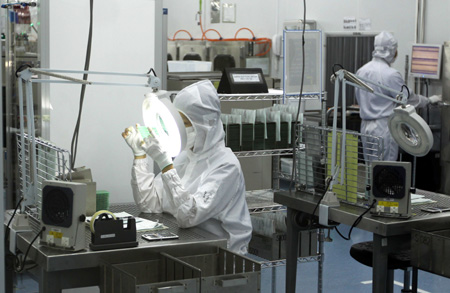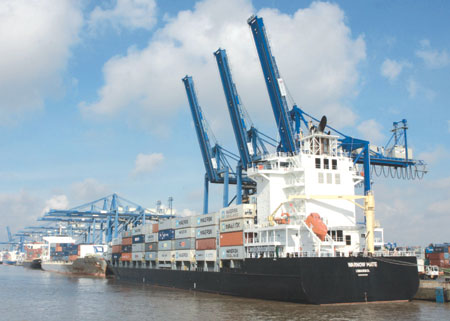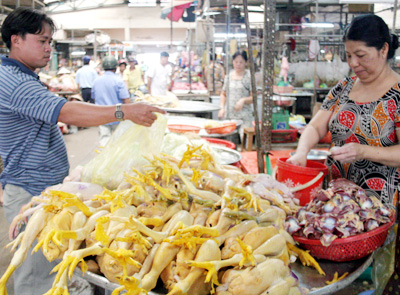Indicators reveal signs of early recovery
Indicators reveal signs of early recovery
Indicators during the last three months are promising signs of an early economic recovery. Gross domestic product in the first quarter grew by 4.89 per cent, the consumer price index fell significantly, while exports and foreign direct investment reported encouraging results.

However, in both the short and long term, it seems the economy will encounter many challenges that could threaten economic growth and make recovery weak and unstable.
Bui Quang Tuan, deputy director of the Viet Nam Institute of Economics spoke to Viet Nam News Agency on the issues.
What do you think about the picture of the macro-economy reflected in the first quarter of this year?
There are not many improvements. Difficulties continuing from last year remained, such as high inventories, especially in the real-estate sector. A large number of enterprises went bankrupt and there was a decline in the market confidence. Interest rates were still high and it was difficult to access deposits.
Many solutions of the Government are going in the right direction; however, most still lie on paper without implementation in reality. Meanwhile, the world economy, despite signs of recovery, remains fragile.
However, the forecast for Viet Nam and the world for the full year is for recovery. Indeed, many signs indicate that the economy is entering a recovery period after hitting bottom.
Stimulation from governments and the invisible hand of the market seem to be adjusting the economy. I think the world economy is recovering more clearly than the period after the 2008-09 crisis. The economy of Viet Nam should benefit from the trend.
The problem is how to implement the Government's measures, such as the Resolution No 2/NQ-CP about tackling difficulties for production and efficiency.
Could you identify some difficulties in the economy in the first quarter? Will they continue?
Stabilising the macro-economy achieves good results. However, difficulties continue from 2012. Resolving non-performing debts is reported to be having positive results. Recently, the State Bank of Viet Nam said the rate of bad debts had decreased from 8.8 per cent to 6 per cent.
However, it will take time to clear high inventories. The high stockpiles lead to lower production and reduce investments. This will have an impact on production for months or even years.
Difficulties will remain in the medium and long term, including the economic restructuring of State-owned enterprises, commercial banks and public investment. The need is urgent, but the results remain limited.
The long-term challenge is to renovate the growth model based on in-depth growth, efficiency and innovation through the enhancement of investment efficiency, infrastructure development - and human resource and decentralisation of management.
One expert said the vicious circle involving bad debt, credit and interest rates had pushed the economy into a stalemate. What do you think?
Not all sectors of the economy fall into this vicious circle, but the real estate sector definitely has. It is in huge difficulties and problems related to inventories, credit for buyers and conversion of projects must be tackled if it is to survive.
It would take a long time to resolve the problems of the real estate sector. In other sectors, such as manufacturing, the situation is not so bad. Some exports and foreign direct investment have been successful. Some FDI projects have been promising, including Samsung's recent project.
The problem is how to engage enterprises, especially those of small and medium s into the recovery trend and only by that, they, themselves, could exit the circle.
What issues should the Government policies focus on?
Policies should continue to focus on stabilising the macro-economy, which is critical. Inflation could return if the Government pays little attention to this.
Secondly, there must be co-ordination between budgetary and monetary policies and between relevant organisations to ensure the consistency. During the past five years, spending was cut twice (2008, 2011) and expanded twice (2009, 2012). This did not help enterprises develop.
The consistency of short, medium and long term policies should also be ensured. In the short term, policies aim to stabilise the macro-economy to create market confidence for investors and enterprises.
For medium and long-term development, policies should aim to restructure the economy and renovate the growth model without relying too much on public investment expansion, which might cause inefficiencies, inflation and macro-economic instabilities.
The resource allocation from central to local levels also needs more focus to ensure efficiency. Finally, I think that the country needs to encourage breakthroughs to boost growth.
For example, special mechanisms should be offered to some localities with high potential for development. This could attract more foreign investments from manufacturing giants.
What is your forecast for the economy in coming quarters as well as the possibility of achieving growth targets set by the National Assembly?
The economy of Viet Nam will see improvements in coming months. This is partly due to the gradual recovery of the world economy, especially the US and Japan.
Oil and food prices are not expected to rise by much this year. And the International Monetary Fund predicts the world economy will grow by 3.5 this year and by 4 per cent next year. However, Viet Nam should not expect to return to the growth rate of 7 per cent or 8 per cent achieved in 2005-06.
Government measures to resolve bad debts are also in the right direction. Tax reduction and deferrals will support enterprises if put into effect soon.
The scenario for medium growth shows that GDP growth rate this year would be from 5.3 per cent to 5.6 per cent, inflation at 7.3- 7.5 per cent and unemployment rate at 3.5 per cent.
With appropriate policies, good implementation and advantageous world conditions, the goals the National Assembly has set for the economic growth are achievable
vietnamnews


























